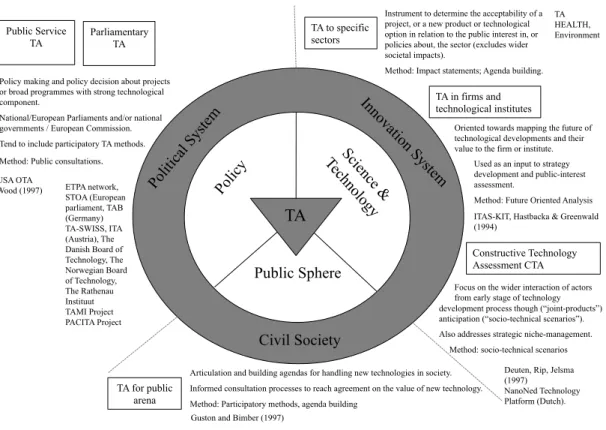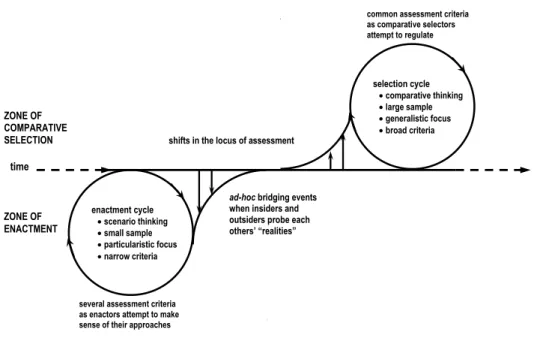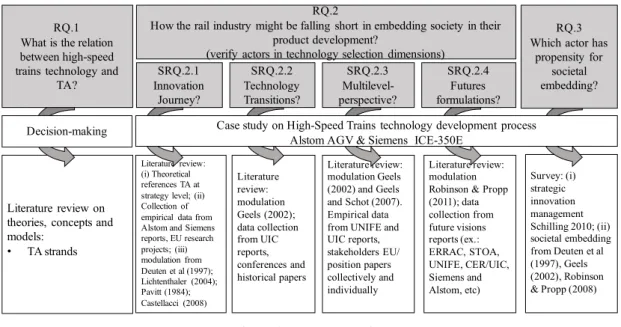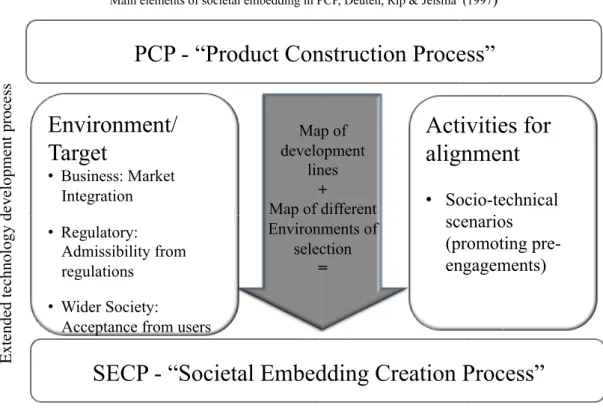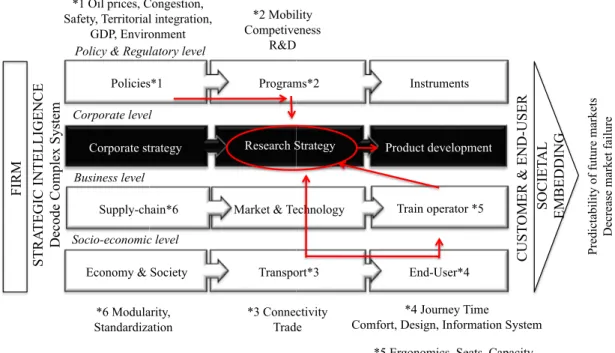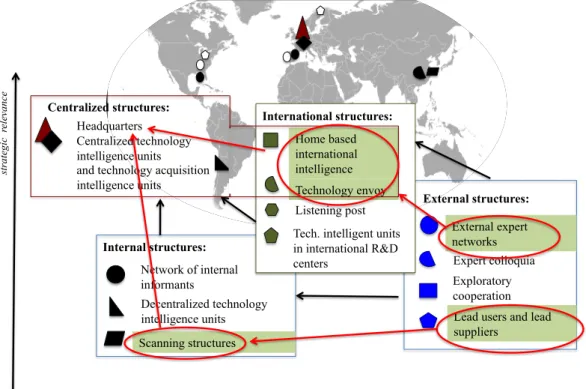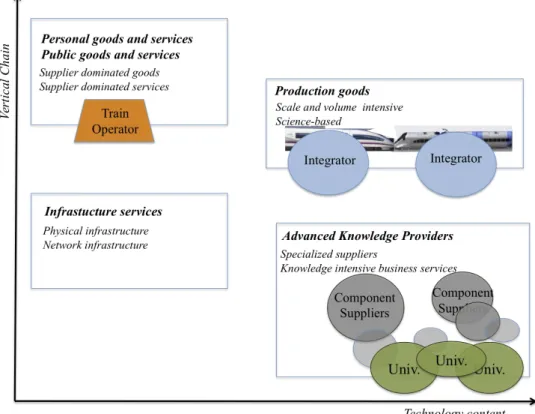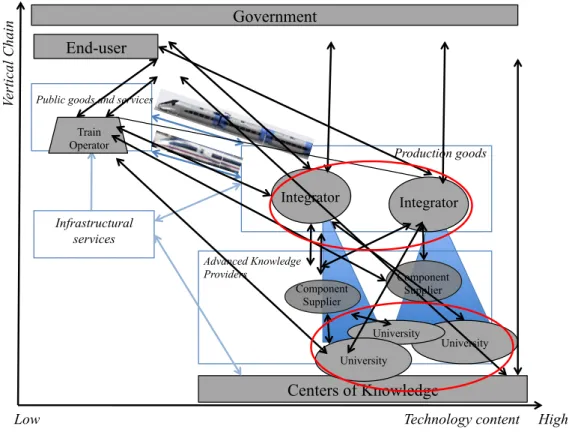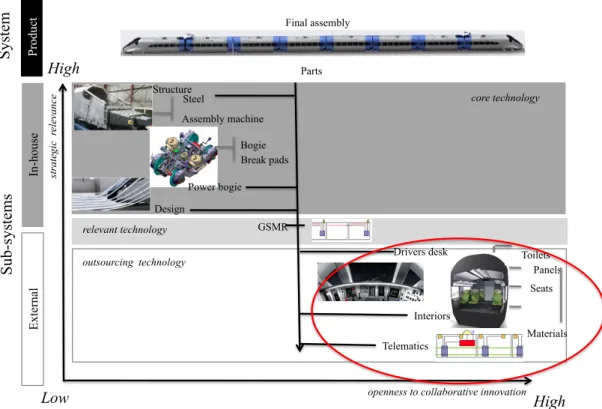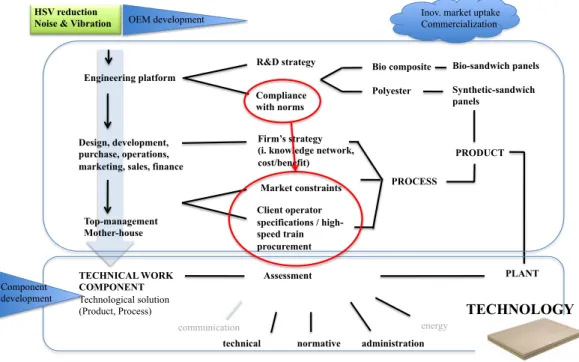Susana Cristina dos Santos Gomes Martins Moretto
Licenciatura em Relações Internacionais, Universidade LusíadaMestrado em Estudos Europeus, Collège d'Europe
Technology Assessment and High-Speed Trains:
facing the challenge of emergent digital society
Dissertação para obtenção do Grau de Doutor em Avaliação de Tecnologia
Orientador:
Doutor António Paulo Brandão Moniz de Jesus, Professor
Associado com Agregação, Departamento de Ciências
Sociais Aplicadas, Faculdade de Ciências e Tecnologia,
Universidade Nova de Lisboa
Co-orientador: Doutora M. Rosário M. R. Macário, Professora Associada,
Departamento de Engenharia Civil, Arquitectura e
Georrecursos, Instituto Superior Técnico, Universidade de
Lisboa
iii!
Technology Assessment and High-Speed Trains: facing the challenge of emergent digital society
Copyright! Susana Cristina dos Santos Gomes Martins Moretto, FCT/UNL and UNL
A Faculdade de Ciências e Tecnologia e a Universidade Nova de Lisboa tem o direito, perpétuo e sem limites geográficos, de arquivar e publicar esta dissertação através de exemplares impressos reproduzidos em papel ou de forma digital, ou por qualquer outro meio conhecido ou que venha a ser inventado, e de a divulgar através de repositórios científicos e de admitir a sua copia e distribuição com objetivos educacionais ou de investigação, não comerciais, desde que seja dado crédito ao autor e editor.v!
vii!
Acknowledgements
During this PhD journey I have sourced from inspiring people met along the way. Here, I leave my expression of gratitude to them by evoking their names and contributions.
The first person is my husband Luca Moretto. He is the most intelligent person I have ever met. He is the main supporter of this enterprise and my main anchor to the corporate world which I left at the early stage of my PhD. Also, my son Alessandro. He born and gown alongside this dissertation. My mother Luisa Martins. The most intelligent woman, entrepreneur and friend. She will eternally live in my heart.
This journey started because of Nuno Boavida. He was an old friend from the early times working in Brussels. We re-encountered years later at a conference in Lisbon. He introduced me to Technology Assessment (TA). The PhD was about to launch in Portugal by Professor Brandão Moníz. Soon after we become PhD colleagues and co-author of papers. I shall say that Nuno was a key element also for our research group with his TA Reading Labs. There he shared a series of reference publications and promoted regular discussions between colleagues. In its turn Professor Brandão Moníz became my dissertation principal supervisor. He was active supporter of my research. His fulltime engagement was essential. His latter sabbatical period at the Institute of Technology Assessment at the Karlsruhe Institute of Technology (ITAS-KIT) in Germany, where significant research projects as PACITA, enlarged our research group. I benefitted from the multiple exchanges with researchers at ITAS, visits to the institute, joint participation in conferences and publications in journals and books. Today the PhD is dual with ITAS-KIT.
Moreover, Professor Manuel Seabra Pereira, pioneer and distinguish element of ERRAC European Railway Research Advisory Council, and Professor Rosário Macário, a woman I admire and leader in transport research, were kind to accept the co-supervision of this dissertation. It extended our long collaboration and friendship from early times in my career when I worked for UNIFE (the European Association for the Railway Industry). Both were a very important link to railway research.
Halfway through my PhD journey I was fortuned to meet Douglas K. R. Robinson, PhD, from the LISIS of Paris Est Marne-la Vallee University. He was a former student of Professor Aire Rip at Twente University. Douglas is a reference author in Technology Assessment and active developer of Rip’s Constructive Technology Assessment (CTA) theory. Douglas became my main and most valuable source of TA insides. He was kind enough to accept to be co-author in various papers, opening doors for publication and presentations. He gave me unconditional
!
!
viii!
support. Also, Jens Schippl, a researcher on Transport Scenarios at ITAS-KIT, became influential in my work and co-author. Both Douglas and Jens directed me to the relevant theoretical references and methods in TA.
My PhD was not only a theoretical journey crossing ways with people from TA and railways as mentioned. It was also a geographical journey encompassing learnings on the broad of strategic innovation management. Soon after I started my PhD in Portugal I moved for personal reasons to Santiago de Queretaro in Mexico. There I entered the academic carrier as researcher and lecturer at the Universidad Autónoma de Queretaro. This was only possible because Professor Alberto Pastrana and Professor Luis Rodrigo Valencia Perez at the Business and Administration School opened the door of their Innovation Lab. I am very much thankful to them for this unique opportunity. In Mexico, I also met a very interesting Professor in Philosophy of Innovation, Fernando Gonzales, PhD. Inspired by Mumford, Professor Fernando Gonzales developed charts from his interpretations to the understanding of technology as tool and process which were source of inspiration in my modeling on high-speed trains technical and commercial trajectories (figures 4.11 and 4.12).
When I later moved to Shanghai, I was very fortunate to meet Professor Chen Song, Vice-Dean of the School of Economics and Management of Tongji University. He was also Professor for Innovation Management. He gave me the opportunity to continue my research and lecture at Tongji. The writing of the final pages of this dissertation happened instead in Hong Kong, where I subsequently moved afterwards. There, Professor Naubahar Sharif from the Social Sciences Department of the Hong Kong University of Science and Technology challenged me to exploit my research results to the Hong Kong Express Rail Link.
I would like to extend my gratitude to the members of the thesis evaluation committee (CAT - Comité de Avaliação de Tese), in particular Professor José Nuno Varandas da Silva Ferreira and Professor Zuzana Dimitrovová, also Professor Prof. Doutor Virgílio António Cruz Machado, Professor Manuel Duarte Mendes Monteiro Laranja, Douglas Keith Raymond Robinson, Nuno Filipe França Gouveia Boavida.
And finally, express my appreciation to the various comments received from anonymous peer reviewers and responses to the survey from the various professionals in the railways and in the Technology Assessment community.
ix!
Abstract
The present PhD dissertation addresses the extension of selective environments of new technologies within the high-speed train technological system from business and regulations to the wider society. And, it argues the recognition of society as an actor in that system.
Motivating it is the observed ever increase exposure of high-speed trains to public acceptance, caused by empowered society from fast ICT advancements. They refer to digitalization - the rise of social media and big data, combined with the widespread use of mobile technology - changing if not revolutionizing our understanding of product and service selection.
Unprecedented societal demands, opening a new market segment, require new technologies to integrate with the emergent digital system. Moreover, societal actors became themselves innovators. Inevitable they have to become part of the value chain widening the collective of stakeholders. However, such raises the dilemma of promotion and control and adds complexity and uncertainty to the industry in deciding which technology to select.
Statistical evidence shows that businesses are figuring out ways to embed societal actors in their value creation. In this dissertation, I demonstrate to the high-speed train industry how is it falling short in addressing societal embedding in their product creation and argue why requires improvement.
Technology Assessment provides the approach for the orchestration of the necessary dialogue with societal actors for better anticipating potential development in the full system and for embedding the resulting technology options within.
By exploiting it to the high-speed train industry innovation strategic management, the aim of my dissertation is, borrowing the words of Douglas K. R. Robinson, to “arrive to a better informed designs of future working worlds, which are structured by theory while empirically well grounded, so they are usable by decision makers”.
With this work, I expect to contribute to the new governance structure for research and development set buy the railway industry SHIFT2RAIL (Joint Undertaking for Rail Research and Innovation).
Key words: Strategic Innovation Management, Technology Assessment, Constructive
xi!
Sumário
Com a presente tese de doutoramento proponho uma nova abordagem na seleção de novas tecnologias integrantes do sistema da alta-velocidade-ferroviária, que efetive a extensão dos tradicionais enquadramentos de triagem (condições de mercado e regulamentares) aos sociais desde a fase inicial do desenvolvimento tecnológico.
O motivo encontra-se no observado fenómeno de crescente relevância social e seus revigorantes atores emergentes da sem precedente digitalização que muda, se não revoluciona, a forma como as novas tecnologias são selecionadas.
Por digitalização entende-se redes socias, “big data”, “cloud”, acompanhados pela utilização de comunicações moveis em rede, geradoras de comunidades de partilha e usuários inovadores. Com as resultantes novas procuras e ofertas sociais, a indústria de alta-velocidade-ferroviária vê-se confrontada com o dilema da “promoção e controlo tecnológico” alargado, o que acresce complexidade e incerteza às existentes praticas de triagem das suas novas ofertas.
Estatísticas demonstram que apesar das medidas exploratórias para a integração social estas têm sido na sua maioria de imagem e marketing e menos no seu envolvimento na criação de valor através da investigação e desenvolvimento.
Da análise desta problemática no sistema de alta-velocidade-ferroviária Europeia, é minha ambição, (usando as palavras de Douglas K. R. Robinson) “chegar a designs mais informados de futuros [tecnológicos] que funcionem, que sejam estruturados pela teoria enquanto empiricamente bem fundados, utilizáveis pelos decisores”.
Para tal pretendo demonstrar como será possível nesta indústria introduzir a Avaliação de Tecnologia, instrumento de apoio à decisão de politicas e estratégias tecnológicas socialmente integradas, para uma orquestração do necessário diálogo entre os promotores das tecnologias e os atores sociais, a implementar por antecipação e integração sistémica das soluções tecnológicas desde a fase inicial de desenvolvimento.
Desta forma espero contribuir para a nova governança da investigação e desenvolvimento da industria ferroviária na Europa recentemente lançada pela iniciativa SHIFT2RAIL (Joint Undertaking for Rail Research and Innovation).
Palavras Chave: Gestão Estratégica da Inovação, Avaliação da Tecnologia, Avaliação da
xiii!
Table of Contents
I.#INTRODUCTION#+++++++++++++++++++++++++++++++++++++++++++++++++++++++++++++++++++++++++++#1!
1.1.#Changing#demands:#what#is#at#stake#for#the#high+speed#train#sector?#+++++++++#1!
1.2.#The#dissertation#++++++++++++++++++++++++++++++++++++++++++++++++++++++++++++++++++++++++++++++#6!
1.3.#Structure#++++++++++++++++++++++++++++++++++++++++++++++++++++++++++++++++++++++++++++++++++++++++#7!
II.#THEORETICAL#REFERENCES#++++++++++++++++++++++++++++++++++++++++++++++++++++++++++#9!
2.1.#Technology#Assessment#++++++++++++++++++++++++++++++++++++++++++++++++++++++++++++++++++++#9!
2.1.1.!Multiple!strands!333333333333333333333333333333333333333333333333333333333333333333333333333!9!
2.1.2.!A!problem!of!selection!3333333333333333333333333333333333333333333333333333333333333333333!11!
2.2.#Constructive#Technology#Assessment#++++++++++++++++++++++++++++++++++++++++++++++++#14!
2.2.1.!Selected!strand!and!its!implications!33333333333333333333333333333333333333333333333333!14!
2.2.2.!Distinctive!theoretical!elements!3333333333333333333333333333333333333333333333333333333!15!
2.2.3.!Origins!and!applications!3333333333333333333333333333333333333333333333333333333333333333!17!
2.2.4.!Theoretical!aspects!of!relevance!for!the!high3speed!train!industry!333333333333!19!
2.2.5.!Theoretical!elements!developed!333333333333333333333333333333333333333333333333333333!21!
2.2.6.!Contribution!3333333333333333333333333333333333333333333333333333333333333333333333333333333!22!
III.#METHODOLOGY#++++++++++++++++++++++++++++++++++++++++++++++++++++++++++++++++++++++++#23!
3.1.#Research#questions#and#propositions#++++++++++++++++++++++++++++++++++++++++++++++++#23!
3.2.#Research#framework#++++++++++++++++++++++++++++++++++++++++++++++++++++++++++++++++++++++#25!
IV.#THE#CASES#OF#THE#AGV#AND#ICE+350E#DEVELOPMENT#PROCESS#++++++++#29!
4.1.#Strategic#intelligence#++++++++++++++++++++++++++++++++++++++++++++++++++++++++++++++++++++++#30!
4.1.1.!Introduction!3333333333333333333333333333333333333333333333333333333333333333333333333333333!30!
4.1.2.!Strategic!function!of!TA!33333333333333333333333333333333333333333333333333333333333333333!33!
4.1.3.!Data!collection!3333333333333333333333333333333333333333333333333333333333333333333333333333!35!
4.1.4.!Organisational!structure!3333333333333333333333333333333333333333333333333333333333333333!36!
4.1.5.!Technology!development!333333333333333333333333333333333333333333333333333333333333333!41!
4.1.6.!Findings!333333333333333333333333333333333333333333333333333333333333333333333333333333333333!53!
4.2.#Technology#transitions#+++++++++++++++++++++++++++++++++++++++++++++++++++++++++++++++++++#56!
4.2.1.!Introduction!3333333333333333333333333333333333333333333333333333333333333333333333333333333!56!
4.2.2.!Theoretical!references!333333333333333333333333333333333333333333333333333333333333333333!58!
4.2.3.!Technology!transitions!AGV!and!ICE3350E!33333333333333333333333333333333333333333!61!
4.2.4.!Findings!333333333333333333333333333333333333333333333333333333333333333333333333333333333333!71!
4.3.#Multi+level#Perspectives#++++++++++++++++++++++++++++++++++++++++++++++++++++++++++++++++++#73!
4.3.1.!Introduction!3333333333333333333333333333333333333333333333333333333333333333333333333333333!73!
4.3.2.!Analysis!3333333333333333333333333333333333333333333333333333333333333333333333333333333333333!73!
4.3.3.!Findings!333333333333333333333333333333333333333333333333333333333333333333333333333333333333!80!
4.4.#Anticipation#through#future#strategic#formulations#++++++++++++++++++++++++++++++#82!
4.4.1.!Introduction!3333333333333333333333333333333333333333333333333333333333333333333333333333333!82!
4.4.2.!Methodology!3333333333333333333333333333333333333333333333333333333333333333333333333333333!84!
4.4.3.!FTA!and!the!European!High!Speed!Railway!system!3333333333333333333333333333333!85!
4.4.4.!Findings!333333333333333333333333333333333333333333333333333333333333333333333333333333333333!96!
V.#SURVEY#++++++++++++++++++++++++++++++++++++++++++++++++++++++++++++++++++++++++++++++++++++#99!
5.1.!Introduction!333333333333333333333333333333333333333333333333333333333333333333333333333333333!99!
5.2.!Data!collection!33333333333333333333333333333333333333333333333333333333333333333333333333333!102!
5.3.!Unit!of!analysis!(Q1,!Q11,!Q12)!33333333333333333333333333333333333333333333333333333333!105!
Results!(Q1,!Q11,!Q12)!333333333333333333333333333333333333333333333333333333333333333333333333!111!
5.4.!Respondents!preliminary!view!on!the!survey!topic!3333333333333333333333333333333!112!
Results!(Q2,!Q3)!33333333333333333333333333333333333333333333333333333333333333333333333333333333!118!
5.5.!Results!33333333333333333333333333333333333333333333333333333333333333333333333333333333333333!119!
A.!STRATEGIC!INNOVATION!MANAGEMENT!33333333333333333333333333333333333333333333!119!
!
!
xiv!
i)!Technology!development!characterization!33333333333333333333333333333333333333333333!119!
Q13.!R&D!expenditure!333333333333333333333333333333333333333333333333333333333333333333333333!120!
Q14.!R&D!strategy!33333333333333333333333333333333333333333333333333333333333333333333333333333!121!
Q15.!Technology!surveillance!333333333333333333333333333333333333333333333333333333333333333!123!
Q16.!Posts!in!technological!surveillance!33333333333333333333333333333333333333333333333333!125!
Results!(Q133Q16)!33333333333333333333333333333333333333333333333333333333333333333333333333333!127!
ii)!Technological!development!multi3level!dynamics!3333333333333333333333333333333333!128!
Q17.!The!purpose!for!undertaking!technology!developments!333333333333333333333333!129!
Q18.!Existing!technology!development!practices!333333333333333333333333333333333333333!136!
Q19.!Openness!to!collaborative!research!3333333333333333333333333333333333333333333333333!138!
Q20.!Technological!partnerships!33333333333333333333333333333333333333333333333333333333333!139!
Q21.!Relevant!factors!for!conducting!collaborative!research!3333333333333333333333333!141!
Results!(Q17!–!Q21)!333333333333333333333333333333333333333333333333333333333333333333333333333!143!
B.!SOCIETAL!EMBEDDING!3333333333333333333333333333333333333333333333333333333333333333333!144!
iii)!Drivers!and!alignments!in!technology!change!333333333333333333333333333333333333333!145!
Q22.!Drivers!for!technology!change!33333333333333333333333333333333333333333333333333333333!145!
Q23.!Requirements!for!technology!change!33333333333333333333333333333333333333333333333!148!
Q24.!Sources!of!drivers!and!requirements!33333333333333333333333333333333333333333333333!158!
Q25.!Appraisal!instruments!333333333333333333333333333333333333333333333333333333333333333333!161!
Results!(Q22!to!Q25)!33333333333333333333333333333333333333333333333333333333333333333333333333!162!
iv)!Societal!elements!in!the!strategic!management!approach!333333333333333333333333!164!
Q26.!What!represents!alignment!with!societal!actors?!33333333333333333333333333333333!165!
Q27.!Management!for!societal!embedding!333333333333333333333333333333333333333333333333!167!
Q28.!Dealing!with!the!anticipation!dilemma!333333333333333333333333333333333333333333333!170!
Results!(Q263Q28)!33333333333333333333333333333333333333333333333333333333333333333333333333333!173!
v)!Futures!3333333333333333333333333333333333333333333333333333333333333333333333333333333333333333!173!
Q29.!Visioning!the!future!333333333333333333333333333333333333333333333333333333333333333333333!174!
Q30.!Sources!of!future!reports!33333333333333333333333333333333333333333333333333333333333333!176!
Q31.!Methods!to!access!futures!3333333333333333333333333333333333333333333333333333333333333!178!
Q32.!Futures!should!consider!333333333333333333333333333333333333333333333333333333333333333!180!
Q33.!Futures!expected!contribution!3333333333333333333333333333333333333333333333333333333!181!
Results!(Q293Q33)!33333333333333333333333333333333333333333333333333333333333333333333333333333!183!
5.6.!Survey!main!results!3333333333333333333333333333333333333333333333333333333333333333333333!184!
A.!!Main!Results!–!Strategic!Innovation!Management!3333333333333333333333333333333333!184!
B.!Main!Results!–!Societal!embedding!innovation!management!333333333333333333333!185!
VI.#FINDINGS#SUMMARY#++++++++++++++++++++++++++++++++++++++++++++++++++++++++++++++++#189!
VII.#CONCLUSIONS,#RECOMMENDATIONS#and#IMPACTS#+++++++++++++++++++++++#195!
BIBLIOGRAPHY#+++++++++++++++++++++++++++++++++++++++++++++++++++++++++++++++++++++++++++#201!
ANNEXES#++++++++++++++++++++++++++++++++++++++++++++++++++++++++++++++++++++++++++++++++++++#215!
Annex#1.#Map#of#the#high+speed#train#network#in#Europe#++++++++++++++++++++++++++#215!
Annex#2.#Survey#questions##++++++++++++++++++++++++++++++++++++++++++++++++++++++++++++++++++#216# Annex#3.#Dissertation#summary#chart#++++++++++++++++++++++++++++++++++++++++++++++++++++#233#xv!
Figures
Figure 1.1.
!
Enterprise use of social networks, by purpose and sector, Europe 28, year 2013!...!5!
Figure 2.2.
!
Simplified taxonomy on the main TA strands!...!12!
Figure 2.3.
!
Enactment and Selection adapted by Robinson (2010) from Garud and Ahlstrom (1997)!17!
Figure 3.4. Research plan!...!26!
Figure 4.5. Extended Product Construction Process to society referred in Deuten et al. (1997)!...!34
!
Figure 4.6. Societal embedding within strategic intelligence!...!36
!
Figure 4.7. Societal embedding and the technology surveillance structure!...!39
!
Figure 4.8. High-speed train multi-actor system!...!42
!
Figure 4.9. Societal embedding within high-speed train multi-actor relations!...!44
!
Figure 4.10. Societal embedding within the product technological system!...!47
!
Figure 4.11. Societal embedding within the technical trajectory!...!49
!
Figure 4.12. Societal embedding within the commercial trajectory!...!51
!
Figure 4.13. Overview of societal embedding in the different dimensions of the high-speed train technology development!...!53
!
Figure 4.14. Technological transitions of the reference high-speed trains worldwide.!...!57
!
Figure 4.15. Rip and Kemp micro-meso-macro approach to locate technology transformations.!...!60
!
Figure 4.16. The French TGV/AGV technology transition!...!62
!
Figure 4.17. German ICE technology transitions!...!67
!
Figure 4.18. The AGV and ICE-35E multi-level perspective from 2001 to 2008!...!74
!
Figure 4.19. High-speed trains technology innovation over time (s-curve)!...!87
!
Figure 4.20. Future strategic reports and multi-level perspective since 2001 to our days!...!92
!
Figure 5.21. Product development process environments!...!100
!
xvii!
Tables
Table!4.1.!Classification!of!reports!on!future!oriented!technology!assessment!(FTA)!referring!to!the! highFspeed!train!system!...!85
!
xix!
Graphs
Graph 5.1. Respondents categories (Q1)!...!106
!
Graph!5.2.!Respondents!categories!resulting!from!their!institutional!affiliation!(Q11)!...!107
!
Graph!5.3.!Breakdown!by!respondents’!institutional!affiliation!(Q11)!...!108!
Graph!5.4.!Country!distribution!(Q12)!...!110!
Graph!5.5.!Country!distribution!by!institutional!types!(Q12)!...!111!
Graph!5.6.!Aspects!valued!when!decision!is!made!to!take!the!highFspeed!train!(Q2)!...!113!
Graph!5.7.!Aspects!valued!when!decision!is!made!to!take!the!highFspeed!trai.!Breakdown!(Q2)!...!114!
Graph!5.8.!Aspects!valued!when!decision!is!made!to!take!the!highFspeed!train.!Breakdown!(Q2)!...!114!
Graph!5.9.!Should!users!and!wide!society!have!a!say!in!the!technology!development!(Q3)!...!116!
Graph!5.10.!Should!users!and!wide!society!have!a!say!in!the!technology!development.!Breakdown! (Q3)!...!117!
Graph!5.11.!HighFspeed!train!industry!expenditure!on!R&D!as!a!%!of!total!turnover!(Q13)!...!120!
Graph!5.12.!HighFspeed!expenditure!on!R&D!as!a!%!of!annual!turnover.!Breakdown!(Q13)!...!121!
Graph!5.13.!Does!your!institution!have!an!explicit!R&D!strategy?!(Q14)!...!122!
Graph!5.14.!Does!your!institution!have!an!explicit!R&D!strategy?!Breakdown!(Q14)!...!122!
Graph!5.15.!Does!your!institution!have!an!explicit!technology!surveillance!structure?!(Q15)!...!124!
Graph!5.16.!Does!your!institution!have!an!explicit!technological!surveillance!structure?!Breakdown! (Q15)!...!124!
Graph!5.17.!You!or!a!colleague!take!part!in!technological!surveillance!as!follows…!(Q16)!...!126!
Graph!5.18.!You!or!a!colleague!take!part!in!technological!surveillance!as!follows.!Breakdown!(Q16)! ….!...!126!
Graph!5.19.!Purpose!for!undertaking!technology!development!activities!(Q17)!...!129!
Graph!5.20.!Purpose!for!undertaking!technology!development!activities:!Product!development!and! design!(Q17a)!...!130!
Graph!5.21.!Purpose!for!undertaking!technology!development!activities:!Manufacturing!process! (Q17b)!...!131!
Graph!5.22.!Purpose!for!undertaking!technology!development!activities:!Modelling!and!planning! (Q17c)!...!131!
Graph!5.23.!Purpose!for!undertaking!technology!development!activities:!Certification!and! homologation!(Q17d)!...!132!
Graph!5.24.!Purpose!for!undertaking!technology!development!activities:!Cost!reduction!(Q17e)!...!133!
Graph!5.25.!Purpose!for!undertaking!technology!development!activities:!Solve!technical!problems! (Q17f)!...!134!
Graph!5.26.!Purpose!for!undertaking!technology!development!activities:!Make!the!final!product! attractive!to!users!(Q17g)!...!134!
Graph!5.27.!Purpose!for!undertaking!technology!development!activities:!Enter!new!markets!or!gain! market!from!competitors!(Q17h)!...!135!
Graph!5.28.!Purpose!for!undertaking!technology!development!activities:!Anticipate!new!societal! challenges,!policies!and!market!conditions!(Q17i)!...!136!
Graph!5.29.!Existing!technology!development!practices!(Q18)!...!137!
Graph!5.30.!Existing!technology!development!practices.!Breakdown!(Q18)!...!137!
Graph!5.31.!Openness!to!collaborative!research!(Q19)!...!138!
Graph!5.32.!Openness!to!collaborative!research.!Breakdown!(Q19)!...!139!
Graph!5.33.!Technological!partners!(Q20)!...!140!
Graph!5.34.!Technological!partners.!Breakdown!(Q20)!...!140!
Graph!5.35.!Relevant!factors!for!conducting!collaborative!research!(Q21)!...!142!
Graph!5.36.!Relevance!of!collaborative!research.!Breakdow.!(Q21)!...!142!
Graph!5.37.!Rate!in!relevance!the!factors!driving!your!research!and!development!(Q22)!...!146!
Graph!5.38.!Drivers!for!technology!change.!Breakdown!(Q22)!...!147!
Graph!5.39.!When!developing!a!new!technological!solution!(TRL)!which!requirement!for!alignment! you!consider?!(Q23)!...!148!
Graph!5.40.!When!developing!a!new!technological!solution!for!the!highFspeed!train!at!which! technological!readiness!levels!(TRL)!you!consider!identified!requirements!for!alignment?! (Q23)!...!149!
Graph!5.41.!Requirements!relevance!at!TRL!1.!Basic!principles!observed!and!reported!(Q23)!...!150!
Graph!5.42.!Requirements!relevance!at!TRL!2.!Technology!concept!formulated!(Q23)!...!151!
!
!
xx!
Graph!5.43.!Requirements!relevance!at!TRL!3.!Experimental!proof!of!concept!(Q23)!...!152!
Graph!5.44.!Requirements!relevance!at!TRL!4.!Technology!validation!in!laboratory!(Q23)!...!153!
Graph!5.45.!Requirements!relevance!at!TRL!5.!Technology!validation!in!relevant!environment! (Q23)..!...!154!
Graph!5.46.!Requirements!relevance!at!TRL!6.!Technology!demonstration!in!a!relevant!environment! (Q23)!...!154!
Graph!5.47.!Requirements!relevance!at!TRL!7.!System!prototype!demonstration!in!an!operational! environment!(Q23)!...!155!
Graph!5.48.!Requirements!relevance!at!TRL!8.!System!completed!and!qualified!through!test!and! demonstration!(Q23)!...!156!
Graph!5.49.!Requirements!relevance!at!TRL!9.!Actual!system!proven!through!successful!mission! operations!(Q23)!...!157!
Graph!5.50.!Indicate!your!sources!of!information!on!technological!drivers!and!requirements! (Q24)…..!...!159!
Graph!5.51.!Indicate!your!sources!of!information!on!technological!drivers!and!requirements.! Breakdown!(Q24)!...!160!
Graph!5.52.!In!which!type!of!instruments!you!base!your!technology!decisions?!(Q25)!...!161!
Graph!5.53.!You!base!your!technology!decision!on!which!type!of!instruments.!Breakdown!(Q25)!..!162!
Graph!5.54.!What!represents!technology!alignment!with!societal!actors?!(Q26)!...!165!
Graph!5.55.!What!represents!technology!alignment!with!societal!actors?!(Q26)!...!166!
Graph!5.56.!Technology!management!includes!the!following!elements?!(Q27)!...!168!
Graph!5.57.!Technology!management!includes!the!following!elements?!Breakdown!(Q27a)!...!169!
Graph!5.58.!Technology!management!includes!the!following!elements?!Breakdown!(Q27b)!...!169!
Graph!5.59.!Technology!management!included!the!following!elements?!Breakdown!(Q27c)!...!169!
Graph!5.60.!Technology!management!included!the!following!elements?!Breakdown!(Q27b)!...!169!
Graph!5.61.!Do!stakeholders!pay!attention!to!societal!embedding!when!setting!their!technology! strategy?!(Q28)!...!170!
Graph!5.62.!Mapping!and!monitoring!relevant!environment!including!society?!(Q28a)!...!171!
Graph!5.63.!Articulation!of!scenarios!for!societal!embedding?!(Q28c)!...!172!
Graph!5.64.!Stimulating!continuous!learning!during!societal!inclusion!process?!(Q28d)!...!172!
Graph!5.65.!Relevance!in!visioning!the!future!(Q29)!...!174!
Graph!5.66.!Relevance!in!visioning!the!future.!Breakdown!(Q29)!...!175!
Graph!5.67.!Futures!sources!of!information!(Q30)!...!176!
Graph!5.68.!Futures!sources!of!information,!breakdown!internal!reports!(Q30)!...!177!
Graph!5.69.!Futures!sources!of!information.!Breakdown!by!institutions!(Q30)!...!178!
Graph!5.70.!Methods!used!in!futures!(Q31)!...!179!
Graph!5.71.!Methods!used!in!futures.!Breakdown!(Q31)!...!179!
Graph!5.72.!Aspects!futures!should!consider!(Q32)!...!180!
Graph!5.73.!Aspects!futures!should!consider.!Breakdown!(Q32)!...!181!
Graph!5.74.!What!futures!should!consider!(Q33)!...!182!
Graph!5.75.!What!futures!should!consider.!Breakdown!(Q33)!...!182!
xxi!
Acronyms
AGV - Automotrice à Grand Vitesse CAM – Computer-Aided Manufacturing CAD – Computer-Aided Design
CER – Community of European Railway and Infrastructure Companies CTA – Constrictive Technology Assessment
DB - Deutsche Bahn AG
MLP – Multi-Level Perspective
MODTRAIN - Innovative Modular Vehicle Concepts for an Integrated European Railway System
EC – European Commission
EC FP – European Commission Framework Programme for Research EIM – European Infrastructure Managers Association
ERA – European Railway Agency
EPTA – European Parliament Technology Assessment network ERRAC – European Railway Research and Advisory Council EUDD – European Modular Train Cabin Concepts
FTA – Future Oriented Technology Analysis GDP – Gross Domestic Product
ICE - Inter City Express
ITA – Institute of Technology Assessment of the Austrian Academy of Sciences
ITAS - Institute for Technology Assessment and System Analysis, Karlsruhe Institute of Technology
NOTA - Netherlands Organization of Technology Assessment NTV - Nouvo Transporto Viaggiatore
OTA - Office of Technology Assessment (United States of America) PCP – Product Construction Process
R&D – Research & Development RQ – Research Questions
SAFETRAIN - Safe Interiors
SERA - Single European Railway Area (COM(2011) 144 final) SECP – Social Embedding Construction Process
!
!
xxii!
SHIFT2RAIL – Joint Undertaking for Rail Research and Innovation (Council Regulation (EU) No. 642/2014 of 6 June 2014)
SNCF - Société Nationale des Chemins de Fer Français
STOA – Science and Technology Options Assessment panel of the European Parliament SRQ – Sub-Research Questions
TA – Technology Assessment
TAB – Office Technology Assessment at the German Parliament TA-SWISS – Swiss Center for Technology Assessment
TGV – Train à Grand Vitesse TRL – Technology Readiness Levels
UNIFE – The Association of the European Rail Industry [Union Internationale des Industries Ferroviaire]
I. INTRODUCTION
1.1. Changing demands: what is at stake for the high-speed train
sector?
In recent years, developments in high-speed trains are receiving greater exposure from non-technical factors external to the traditional product design and business steaming from rapid developments of digital society.
Society has become empowered through social media, big data and the cloud, which, combined with the exponential rate of adoption of mobile technologies, is producing widespread service and social innovations. Examples include connected travellers, car sharing, car-pooling, etc.
This pressure adds to other existent societal challenges such as the after-effects of the financial crisis and the drive for sustainable innovation systems, with climate change, congestion, security and the aging population in Western societies (COM (2011) 144 final1).
An example of empowered society by digitalization is BlaBlaCar 20 million users, overpassing SNCF-Voyage market share (Chen 2015 and Casprini et al, 2015). The French railway company operating the TGV, responded introducing mobility services beyond the high-speed train, reducing tariffs and improving online information to travellers (Picard 2015, Steinmann 2014).
In turn manufacturers, such as Alstom Transport and Siemens Mobility2, have been responding in the way they know best, through engineering. These firms are integrating lightweight and recyclable materials into their trains as well as energy converter systems. They are also making the train interiors attractive and further developing ICT solutions for better interfaces with travellers (Brandes, 2015, Saint-Martin, 2015).
As it will be here demonstrated, in railways the need for innovating through digitalization is coming strongly from the demand side, the so-called societal environments of new products selection (Deuten, Rip & Jelsma 1997), and only to a less extent from business, regulation and product
1 The White Paper on a Roadmap to a Single European Transport Area (COM(2011) 144 final) stresses the need to create
a Single European Railway Area (SERA) to achieve a more competitive and resource-efficient transport system capable to address the existent societal issues as here listed.
!
!
2
development. This societal demand is challenging incumbents in railways to include resulting new demands and requirements into the product development processes of high-speed trains.
This relatively recent societal pressure for digitalization, through the exponential growth and use of mobile technology, has coincided with other industrial factors that are driving the directions of transport innovation in the established European railway industry. These factors include high expectations concerning the almost “certain” expansion of high-speed train networks, an increase in international passenger traffic and, most relevant for this dissertation, the market uptake of new technologies coming out from a decade of EU and member states stimulus3.
Notorious is the case of the latest generation of high-speed trains in Europe, the AGV4 and
ICE-350E, and their embedded sub-systems (train-control-command systems, coupling systems, interiors, telematics and advanced materials, sub-systems interfaces, only to refer to some of the examples)5.
The AGV and ICE-350E were designed and developed in response to the changing regulatory and business environments from 2001 impacted by the European Commission initiative known as the White Paper for Transport (COM (2001) 370). However, these trains were still far from including digitalization in their design revealing a lack of exposure to and knowledge about the first signs of the digital pressures of today.
At the time of development of the AGV and ICE-350E, the business environment was favoring the emergence of economies of scale and entrance of new private train operators in competition with incumbents, to provide market liberalization, interoperable networks and opening of infrastructure access.
Also, the new regulatory requirements introduced in a sequence of railway-packages placed a heavy focus on the integration of the different national systems across Europe. The vehicles had to be
3 EU and Member States investments since 2001 to 2014 added more than 6,000 km of high-speed track to the 1,000 km
in 1990 on which trains travel at 250kph or above. Much more is under construction or planned (see UIC map in Annex 1). In December 2015 a new line from Leipzig to Erfurt was inaugurated (123km-long). A Milan-Brescia service is to begin during 2016 (39 km of high-speed track to be added). By 2017 four new French lines will come into service linking Bordeaux, Rennes, Strasbourg and Montpellier. The EU also plans to finance a €4.5 billion fast-rail link between Estonia, Latvia, Lithuania and Poland. Retrieved from http://www.economist.com/news/business/21638109-high-speed-networks-are-spreading-fast-face-rising-competition-problems-down-line see also https://en.wikipedia.org/wiki/High-speed_rail_in_Europe
4 AGV, Automotrice à Grand Vitesse, manufactured by the French firm Alstom presented in 2008 the European
high-speed train in its true sense since it incorporates the results of a number of flagship European projects and also it was the first train developed to meet not a specific order from a train operator but to meet a new regulatory environment. Retrieved from link http://en.wikipedia.org/wiki/Automotrice_%C3%A0_grande_vitesse#Customers, date 11.03.2015.
5 This dissertation focus on vehicles only (rolling stock and its components). Excluded are other parts of the high-speed
capable of running in a trans-European high-speed network that was set to become modular, interoperable, sustainable and safe.
In response the European high-speed train supply chain aligned in different collaborative research projects such as MODTRAIN (European Commission, 2006a, p.336-338), EUDD (European Commission, 2006a, p.330-332) and SAFEINTERIORS (European Commission, 2006a, p.414-416) with financial support via the European Commission Framework Programme for Research (EC FP). These and others projects represent a total budget of roughly 267 Million EUR6 of funding
by the European Commission allocated to railways between 2002 and 2013.
Manufacturers pushed for the technology development of their high-speed train platforms TGV and ICE into standardised ones, beyond individual customer orders. They aimed to result in off-the-shelf vehicles. A true novelty in this industry.
This way the AGV and the ICE-350E when introduced to the market, in 2008 and 2006 respectively, integrated many of the results from those and other collaborative projects.
The market-uptake of these trains was however much lower than initial expectations. Alstom had to wait approximately four years to deliver 25 units of the AGV to the private operator from Italy NTV7, with no further orders since8. As for Siemens, it started suffering from increasing technology
capability pressure from the Chinese competitor CSR Qingdao Sifang, which itself resulted from a previous decade worth of massive expansion of the Chinese high-speed network.
Manufacturers point the finger to the dominant conservative business culture of European railways. Incumbent train operators were resistant to the opening of the market and to regulatory integration (OECD, 2013). In addition, new emergent markets demonstrated a preference for lower cost trains
6 The budget here referred correspond to the sum of the EC funding allocated to rail, being EUR 117 Million in FP6
2002-2006 plus EUR 150 Million in FP7 2006-2013 retrieved from the link
http://ec.europa.eu/research/transport/rail/index_en.htm (14.03.2016).
7 NTV (Nouvo Transporto Viaggiatore) is the Italian private high-speed train operator. Retrieved from link
http://en.wikipedia.org/wiki/Automotrice_%C3%A0_grande_vitesse#Customers, date 11.03.2015.
!
!
4
from China. The most critical voices9 said that new technological solutions resulting from European
research projects did not manage more than a disappointing 30% of leverage effect 10,11.
To overcome these challenges, the railway industry, led by the train manufacturers, are now promoting a new governance structure for the various European research projects with the Joint Undertaking SHIFT2RAIL12. It focusses on technological demonstrators and is reviewing the
mandate of ERRAC Technology Platform13.
What seems to be left out from initiatives like SHIFT2RAIL and from developments such as AGV and ICE-350E is the recent surge of a digitally empowered society which has specific expectations, requirements and needs. Whilst the digital society is surging ahead, high-speed train industry is rapidly being left behind14. Following this train metaphor, will innovation in the high-speed trains take a different route and perhaps crash into these demands much further down the line? Or can anticipation and integration of these new design requirements be included in the innovation processes?
As it will be demonstrated, despite the industry’s initial steps in making the necessary connections with the digital society and address their new emergent needs, they are still oriented towards promoting image and marketing of high-speed trains. Secondary appears to be their interest integrating this new phenomenon in the technology development process of the trains.
9 ERRAC questions in one of its reports if the research projects funded by the European Commission in the past years,
representing millions of Euros of investment, have been actually useful or relevant. Sourced from ERRAC report working group six WG06, 2010. Retrieved from link www.errac.org/spip.php?article25 date 5.03.2013.
10 When enquired ERRAC WG06 by email (2 June 2014) the same figures were referred: “the percentage of successful
projects in Europe (meaning EU part financed research) are around 30%; In Australia about 20%; In north America about 40%. All deals with collective partly governmental financed. The main reason for the poor figures are the complete lack of business perspective in creating ideas”.
11 European Commission, DG MOVE, Council Land Transport Working Party, Brussels 22 January 2014. Retrieved from
link http://www.belspo.be/registration/shift2rail/SHIFT%C2%B2RAIL-O.%20Coppens-Brussels-021714.ppt date 26.09.2014.
12 SHIFT2RAIL (also S2R JU) was launched by the Council Regulation (EU) No. 642/2014 of 6 June 2014 extending to
research and development funding prototyping and large-scale demonstration activities. The European Commission in its impact assessment refers that SHIFT2RAIL is justified because of “(…) the market uptake and impact of EU rail research and development projects under previous framework programmes has often been low and slow (…)” (COM(2013)922 final) Links http://ec.europa.eu/transport/modes/rail/shift2rail_en.htm and http://eur-lex.europa.eu/legal-content/EN/TXT/PDF/?uri=CELEX:52013SC0535&from=EN retrieved 11.03.2015.
13 www.errac.org
14 At the UIC 9th World Congress on High Speed Rail 2015 in Tokyo railways reflected the first signs of awareness on
the disruptive power of digital society and ICT, in particular with the interventions of Rachel Picard, CEO, SNCF Voyages. According to Mrs Picard “digital society revolution” is triggering railways transition into a new technological era (…). In the last 15 years railways made a transition from the hardware into software era, entering today into the socialware, with the connected objects resulting in an exponential acceleration. She further states that this will open future fields of ICT application for railways as in vehicle/infrastructure interaction, maintenance and customer relations. But, as she continues, if for the automotive sector the response is already there with the automated vehicles, for railways one does not yet know what will happen (recorded round table 2, day 7/9/2015, time 10:35-12:45, ref. new record Picard 2/9/2015, from -2:13/00:11:58). Link www.uic-highspeed2015.com .
This lack of embedment of digital society in the research and development process is visible in a broad statistical study on the use of social media across different sectors (Giannakouris & Smihily, 2013). See figure 1.1, below, highlighting transport and manufacturing.
!
Figure 1.1. Enterprise use of social networks, by purpose and sector, Europe 28, year 2013 Source: extract from figure 4. in Giannakouris & Smihily (2013)
The involvement of social networks, via social media, in the technology development (in the figure referred in more restrictive terms as R&D) is no easy task for the high-speed industry, since such requirements fall outside their traditional “engineering” culture historically sheltered from strong market forces.
Engineers dominate these industry technology advancements, which despite their awareness and willingness have neither inclination nor training to address inherent social environments of selection in which research projects might fall15.
Summarising the above, in the past decade we have seen a number of critical shifts affecting the high-speed rail industry: (a) liberalised markets and more competition (e.g. China and other players entering European markets), (b) the regulation environment stimulating modularity and standardisation across national rail innovation systems, and (c) most recently new demands stemming from the rapid rise of the digital society.
15 They associate society to a high degree of heterogeneity and uncertainties tending this way to leave it out from their
R&D collective action, which they compete to control (read Chapter V Survey).
26% 27% 29% 41% 40% 50% 55% 69% 73%
Transport and Storage Manufacturing All sectors
!
!
6
1.2. The dissertation
With this dissertation I attempt to respond to two central questions: (i) How the industry might be falling short in embedding society in their product creation? and (ii) Why there is potential for improvement?
To accomplish it I shall mobilise an approach of Technology Assessment (TA) which includes at its heart design thinking. The approach called Constructive Technology Assessment (CTA) introduces the tools for anticipating the societal embedding of new technologies and integrating this knowledge into the design of products (Deuten et al 1997, Van Merkerk 2007, Robinson 2010), or, at a broader meso-level, the design of industries (Robinson and Boon 2014, Parandian 2012, Mazzucato and Robinson 2015). CTA often involves orchestrating collective anticipation and design (Robinson 2010, te Kulve 2011, Krabbenborg 2013) when elaborating strategies, visions and research projects.
Phrased in another way, in the words of Jens Schippl (interview protocol J. Schippl 20.5.2015) TA provides the methodology for better anticipating potential development in the full system and for embedding the resulting technology options within.
According to Douglas K. R. Robinson (interview protocol D. K. R. Robinson 20.5.2015) social dialogue requires tailored interactions to suite the technology readiness level in which the research project is (to optimise the value from such interaction) and move towards stabilizing design trajectories by reviewing societal requirements at early stages of the research projects (as means to reduce uncertainty and risk). This requires draw on a third party societal expertise to overcome referred dilemmas of promotion and control.
It is this flavour of CTA I will draw upon, what Schippl and Robinson have called the system (or meso) level of industries and railway systems16 .
As Robinson (2010)17, I shall locate my CTA at the meso-level of public-private consortia
anticipating and coordinating an evolving industry. I thus focus on providing strategic intelligence for public-private consortia, such as SHIFT2RAIL (the Joint Undertaking for Rail Research and Innovation), with an eye to creating increased reflexivity about societal dimensions.
In this dissertation, I build my argument from a case-based analysis on how societal embedding “occurs” in the technology development process of two reference high-speed trains; the AGV and
16 As opposed to CTA applied to individual projects or technologies fields (see lab-on-a-chip work by Rutger van Merkerk
2007, or supply chain analysis by Alireza Parandian 2012).
the ICE-350E. To do this, I investigate both train manufacturers18 technological strategy
formulation and implementation activity, the high-speed train technology transitions over time and at multiple scales of stakeholders’ dynamics. I also study the way that industry formulates their visions of the future. To further ground and support these analyses, I have conducted a survey to corroborate my findings in the other elements of my study.
I conclude this dissertation with a reflection on what can be learned from analysing societal embedding in high-speed train development, and propose ways for supporting integrating ideas of societal embedding into the agenda setting process, in particular when railways elaborate their visions and undertake R&D projects in view of a next generation of high-speed trains.
1.3. Structure
This dissertation is the result of a journey. As I have already mentioned, my starting point was to find evidences of societal embedding in railway technology development processes (or product development processes) by doing case studies of the latest generation of high-speed trains, the AGV and the ICE-350E (chapter IV). The goal is to present at the end reflexive19 guidelines for
embedding societal factors in new technology development processes in railways.
Intermediate steps between the start and finish of this journey include the study of Alstom and Siemens strategic intelligence in the development process of the AGV and ICE-350E (section 4.1); the vehicles technology transitions (section 4.2) and their multi-level perspectives (section 4.3.); as well as industry future formulations on desirable futures (section 4.4).
Each of those steps intercepts and follows the footsteps of an emerging path of a constructivist perspective of technology assessment – starting with Arie Rip (Schot and Rip 1997, Deuten, Rip & Jelsma, 1997, and te Kulve & Rip, 2011), one of Rip’s students, Douglas K.R. Robinson (Robinson & Propp, 2008, Robinson 2010, Robinson and Boon 2014), as well as Jens Schippl (Schippl and Fleischer, 2012). My dissertation reflects not only what I have absorbed from their various papers but also the multiple personal contacts and the privilege of joint works. I have also sourced from scholars in innovation studies and evolutionary theories of (socio-)technical change such as Nelson & Winter (1977), Dosi (1982), Pavitt (1984), Castellacci (2008), Lichtenthaler (2004) and Geels (2002).
18 Alstom Transport and Siemens Mobility
19 “Reflexive” here refers to CTA reflexivity, as explained in Rip and Robinson (2013), from interactions and mutual
learnings occurring between the broaden of institutions and approaches in society and sectors in society during co-developments of technologies.
!
!
8
My preliminary findings were corroborated through a broad online-survey to the industry segments of the value chain (Chapter V), with 74 stakeholders replying to the survey covering rolling stock manufacturers, component suppliers, certification bodies, academia, governments and users. Moreover, in parallel, the preliminary findings for each of the steps were presented at several conferences held between 2010 and 2016. The most significant ones were PACITA 201320 and
201521, the JRC Conference on Future-Oriented Technology Analysis (FTA) 201422, the UIC World Congress on High Speed Rail 201523, TRA 201624 and WCRR 201625. Those were organised
separately by the two different communities in which my research is anchored: the railway conferences where actors from the railways supply chain were present, and the technology assessment and foresight conferences where academia and R&D policy makers were present. Those same preliminary finding have also been subject to scrutiny from anonymous peer reviewers when published in conferences proceedings, peer-reviewed journals and as chapters in books. The most relevant ones are the International Journal of Railway Technology26 and PACITA 2012 book27. These discussions and reviews have provided valuable inputs into the writing of this
dissertation as well as in my evolving research programme during this PhD.
Finally, findings are presented in Chapter VI. Conclusions, recommendations and impacts are found in Chapter VII. The bibliography is given at the end.
20 Links http://pacita.strast.cz/en/conference/programme/ix-assessing-sustainable-mobility and
http://pacita.strast.cz/files/prezentace/session_ix_moretto.pdf 21 Link http://berlinconference.pacitaproject.eu/preso/ 22 Link https://ec.europa.eu/jrc/en/event/site/fta2014 23 Link http://www.uic-highspeed2015.com/about/index.html 24 Link http://www.traconference.eu/programme/overall-programme/ 25 Link http://www.wcrr2016.org/ 26 Link http://www.ctresources.info/aresults.html?q=S.+Martins+Moretto 27 Link http://www.pacitaproject.eu/documentation/
II. THEORETICAL REFERENCES
2.1. Technology Assessment
2.1.1. Multiple strands
The dissertation both mobilises and contributes to Technology Assessment (TA).. The rapid
growth of ever complex technologies and the increased visibility of technology’s role in shaping society place TA as an approach of a number of fields in social science and humanities, management and strategy.
Because of the ever increasing recognition on the importance of technological innovation on the economy and on society, TA is becoming more mainstream, more formalised and more embedded in institutions such as parliaments and firms28.
Common to all TA strands, it is the wish to reduce the potential negative consequences of new and emerging technologies and to optimise the uptake and socio-economic impacts of new technologies (Schot and Rip 1997, Rip 2001).
Rip (2001, p.15512:15515, based on Schot & Rip 1997) points to another important role of TA, not entirely shared across all stands, that they contribute to the “(...) early identification and assessment of eventual impacts of technology change and applications in order to reduce the human and social costs of handling a technology in society compared when this happens by trial-and-error”.
TA does have a history and one can describe it in terms of generations of TA. -! First generation of TA strands
The first generation of TA strands was policy-oriented emerging in the 1960’s in the U.S. with the advent of the Office of Technology Assessment (OTA). At the time U.S. Congress saw the need to have advanced warnings on the potential societal, economic, ethical and political effects of new technologies in the U.S. and elsewhere. Thus, TA has its origins in providing useful intelligence for public policy.
!
!
10
Around that period of time, TA was defined as “the name for a class of policy studies which attempt to look at the widest possible scope of impacts in society of the introduction of a new technology. Its goal was to inform the policy process by putting before the decision maker an analysed set of options, alternatives and consequences” (Coates 1976, p139).
However, as Tran et al. (2008) pointed out, at the end of the 1970s, American industry picked up the term of TA quite independently of the OTA definition, more in line with notions of technology readiness assessment. This industry stand used TA as a means of anticipating what was going on outside of their firm to see how it affected their own activities (as opposed to anticipating the effect of their technology developments on markets and society).
Moreover, whilst in the U.S. the Congress dissolved OTA in 1995, policy oriented TA was heterogeneously spreading across a number of public agencies in European countries with participatory traditions such as in Germany, Denmark, Switzerland and the Netherlands (Van den Ende et al. 1998, Rip 2001).
A branch of such activities can be defined as parliamentary TA. TAMI report (2004) and most recently PACITA project (2011-2015)29 have been important European projects focusing efforts on sharing best practices and harmonising parliamentary technology assessment, in spite of the vast heterogeneity.
-! Second generation of TA strands
The second generation of TA strands, emerging in the mid-1980s and early 1990’s, shows an uptake of TA by non-governmental institutions. In this wave, firms begun applying TA along the same lines as the original OTA thrust, as opposed to TA as technology readiness assessment (see earlier).
Here, TA acts as a tool in supporting strategies up to and including agenda building (Rip 2001, Van Eijnshoven 1997). During this time, TA became process oriented developing tools and methodologies targeted at shaping new technology developments in line with emerging demands.
The variety of methods applied ranged from trend exploration and Delphi, through to interventions in innovation networks and consensus meetings (Van den Ende et al. 1998). It is no coincidence that this 2nd generation of TA coincided with the emergence of
biotechnology, which began to raise societal concerns in the mid-80s well into the 90s and
2000s, especially with regards to genetically modified organisms. A pressure to anticipate on societal impacts became a pressing issue, which shaped motivations and approaches to TA. Shedding light on the blurry borders between the different TA strands, Rip (2001) offers a typology of TA including: “Public Service TA”, “TA for public arena”, “TA to specific sectors”, “TA in firms and technological institutes” and “Constructive Technology Assessment”.
Böhle & Moniz (2015), building on such a typology, characterise TA in terms of the different spheres in which those strands might fall: the “Policy sphere”, dealing with the “political system”; the “Public sphere” referring to “civil society” and the “Science & Technology sphere” dealing with the research and innovation system.
2.1.2. A problem of selection
Rip, Böhle and Moniz suggest that the applicable sphere to the cases or problems under analysis depends to whom TA addresses. It can be either decision-makers part of the policy system, civil society from the public sphere or firms and non-governmental bodies from the innovation system (Böhle & Moniz, 2015).
The authors contribute to overcome TA strands tenue boundaries. TA have multiplied in strands often overlapping, making it no small task for those who wish selecting the appropriate one30.
To capture, and further develop, these authors efforts, I have created a simplified taxonomy on the main TA strands, shown below in figure 2.2, which can help locate them.
30 In my research for literature on types of TA strands I also found Van den Ende et al. (1998) presenting a
classification and methods. However I rather followed Rip (2001). This because Van den Ende et al. (1998) refers as types of approaches “Strategy Making” aside to CTA which is itself part of strategy making (in “supporting specific actors or groups of actors in formulating their (…) strategy” as said in van den Ende et al.1998, p.8:5-21). Van den Ende et al. (1998) also indicate backcasting as a type of TA, where in fact it seems to me rather a methodology. CTA in transport uses backcasting as in Schippl (STOA 2008). Moreover, Rip (2001) does not refer to this paper (van den Ende et al., 1998) following a classification based on the TA addressee. Nevertheless, Van den Ende et al. (1998) provide a useful explanation on the origins of TA and present a very comprehensive structure of TA methods.
!
!
12
Figure 2.2. Simplified taxonomy on the main TA strands Source: Böhle & Moniz (2015) chart combined with Rip (2001)
Figure 2.2 shows, for each approach, their relevant aspects in terms of scope, the dominant methods, key authors and, where possible, reference practitioners similar to those referred to in Rip (2001); matched with the spheres concerned (from Böhle & Moniz, 2015) 31.
The spheres in figure 2.2 can be broadly describe as follows: a)! Policy
In Policy predominate Public Service TA (Rip, 2001) and Parliamentary TA (Böhle & Moniz, 2015). These strands support decision making about projects or programmes that have a strong technological component (Rip, 2001). The main addressees are National or European Parliaments or governments including the European Commission. The main instruments used are public consultations and sometimes involve TA participatory methods. Theoretical references in the U.S. are Wood (1997) drawing on methods used by the now defunct OTA, while in Europe are the TAMI reports and PACITA project, where methods, including consensus conferences, guide TA applications by organisations such as the ETPA network,
31 In figure 2.2, for simplification reasons, I only refer to the main strands and intentionally exclude sub-strands that
exist or are emerging (such as real-time TA).
Public Sphere Civil Society TA TA Public Service TA Parliamentary TA
Policy making and policy decision about projects or broad programmes with strong technological component.
National/European Parliaments and/or national governments / European Commission. Tend to include participatory TA methods. Method: Public consultations.
USA OTA
Wood (1997) ETPA network, STOA (European parliament, TAB (Germany) TA-SWISS, ITA (Austria), The Danish Board of Technology, The Norwegian Board of Technology, The Rathenau Instituut TAMI Project PACITA Project TA to specific sectors
Instrument to determine the acceptability of a project, or a new product or technological option in relation to the public interest in, or policies about, the sector (excludes wider societal impacts).
Method: Impact statements; Agenda building.
TA for public arena
Articulation and building agendas for handling new technologies in society. Informed consultation processes to reach agreement on the value of new technology. Method: Participatory methods, agenda building
Guston and Bimber (1997)
TA in firms and technological institutes
Used as an input to strategy development and public-interest assessment.
Method: Future Oriented Analysis ITAS-KIT, Hastbacka & Greenwald (1994)
Constructive Technology Assessment CTA
Focus on the wider interaction of actors from early stage of technology
Also addresses strategic niche-management.
Deuten, Rip, Jelsma (1997)
NanoNed Technology Platform (Dutch). Oriented towards mapping the future of technological developments and their value to the firm or institute.
development process though (“joint-products”) anticipation (“socio-technical scenarios”).!
Method: socio-technical scenarios TA HEALTH, Environment!
STOA (European parliament, TAB (Germany), TA-SWISS, ITA (Austria), the Danish Board of Technology32, the Norwegian Board of Technology and the Rathenau Instituut.
b)! Public
In Public, concerning civil society, is dominant TA for public arenas (Rip, 2001). It refers to the articulation and building of agendas for handling new technologies in society; it also includes informed consensus processes to reach agreement on the value of a new technology (Joss and Durant 1995), Kilver 1995). Here it is mainly used for participatory methods and agenda building. Illustrative references include Guston and Bimber 1997, Guston 1999, Russell et al. 2010.
c)! Science & Technology
In Science & Technology, concerning the innovation system, are included TA to specific sectors, TA in firms and technology institutes and Constructive Technology Assessment.
TA to specific sectors, refers to instruments designed to determine the acceptability of a project, new product or technological option, in relation to the public interest in, or policies about, the sector, excluding wider societal impacts (Rip 2001). The most used methods include impact statements and agenda building. These concern the formal strands of Health TA or Environment TA.
TA in firms and technology institutes is oriented towards mapping the future of technological developments and assessing (prospectively) their value to the firm or institute. Used as an input into strategy development and public interest assessment. Recurrent method is Future Oriented Analysis. Reference authors include Hastbacka & Greenwald (1994).
Constructive Technology Assessment (CTA) focuses on the wider interaction of the broad range of actors (including society) that have a “stake” in the development, deployment and use of new technology fields (Robinson 2010). CTA has often focused on technology fields in their early stage of emergence, where uncertainty reigns and there is a need to both characterize potential future developments and also to construct assessment approaches collectively to assess these new developments (Robinson 2010). Originally developed in the Netherlands, early 1980s, particularly through a dedicated programme organized by the national nanotechnology initiative NanoNed (Rip and van Lente 2013), CTA has experienced periods
32 The Danish Board of Technology, after resources were withdrawn, has now become a foundation. Link
!
!
14
of intense development and application, interspersed with periods of dormancy. In the past three or so years, CTA has been less visible.
2.2. Constructive Technology Assessment
2.2.1. Selected strand and its implications
For this dissertation, the subject of the technology assessment is the high-speed train value chain, and thus, a TA exercise falling within the innovation system part of the science & technology sphere of railways.
The research problem presented in the introduction, concerns the strategic management of the extended high speed rail value chain to include the broad of society at the early stage of development of high speed vehicles. Thus, a TA to direct and shape ongoing developments of emerging technologies.
From the families of TA that I have covered, the most relevant strand turns out to be CTA, which emphasises anticipation and the feeding back of insights from TA activities into the design of new technologies themselves by broaden of networks of actors. CTA is not done after technologies have emerged, but is based on anticipation, reflection and intervention – highly suited for strategic management of rapidly evolving (and uncertain) value chains.
The case of high speed trains looks both at the product level (the high-speed train vehicle) and at the system level (the high-speed train value chain and infrastructures that support it). CTA applies several methods which serve two main purposes (Schot and Rip 1997) the one of analysis making (e.g. aiming at setting the scene through problem identification, phase in which is the technological development is, actors involved and their expectations) and practice-oriented (e.g. interventions allowing for future technology formulations embedding society). CTA is informed by analysis of the dynamics of technical change, tracing the evolution of the innovation journeys of new product developments (Van de Ven 1999, Rip 2012) or multi-level perspective (Geels 2002, Robinson 2009) and multi-actor dynamics (Parandian 2012). Common methods and approaches applied in CTA include socio-technical scenarios developed by Robinson and Rip (see Rip and te Kulve 2008, Robinson 2009, Parandian and Rip 2013), expectations mapping (van Merkerk and Robinson 2006), open-ended roadmapping (Robinson et al. 2013), multi-stakeholder workshops (Krabbenborg 2013), bridging events (as formulated by Robinson 2010, p13) and backcasting (Schippl 2008).
